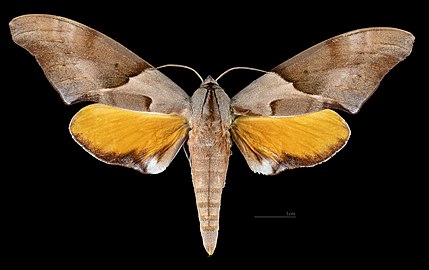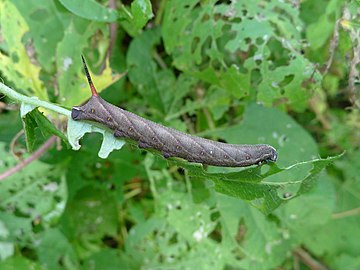| Coequosa australasiae | |
|---|---|

| |
|
Scientific classification
| |
| Domain: | Eukaryota |
| Kingdom: | Animalia |
| Phylum: | Arthropoda |
| Class: | Insecta |
| Order: | Lepidoptera |
| Family: | Sphingidae |
| Genus: | Coequosa |
| Species: | C. australasiae
|
| Binomial name | |
| Coequosa australasiae | |
| Synonyms | |
| |
Coequosa australasiae is a species of moth of the family Sphingidae.
Distribution
It is known from New South Wales, the Northern Territory, Queensland and Victoria.
Description
The wingspan is about 120 mm. The forewings are light and dark brown with a variable wavy pattern and the hindwings are orange with a brown trailing edge. [2]
-
Male dorsal
-
Male ventral
-
Caterpillar
Biology
The larvae feed on the foliage of Eucalyptus species. They have a large last abdominal segment and a tiny forked head. They are green and covered in small warts. There is a diagonal yellow stripe on each side of each abdominal segment. Full-grown larvae are about 120 mm long. Pupation takes place in a dark brown pupa which is formed in a sparse cocoon in the ground litter.
References
- ^ "CATE Creating a Taxonomic eScience - Sphingidae". Cate-sphingidae.org. Archived from the original on 2013-04-19. Retrieved 2011-11-01.
- ^ "Australian Insects". Lepidoptera.butterflyhouse.com.au. 2010-01-25. Retrieved 2011-11-01.
| Coequosa australasiae | |
|---|---|

| |
|
Scientific classification
| |
| Domain: | Eukaryota |
| Kingdom: | Animalia |
| Phylum: | Arthropoda |
| Class: | Insecta |
| Order: | Lepidoptera |
| Family: | Sphingidae |
| Genus: | Coequosa |
| Species: | C. australasiae
|
| Binomial name | |
| Coequosa australasiae | |
| Synonyms | |
| |
Coequosa australasiae is a species of moth of the family Sphingidae.
Distribution
It is known from New South Wales, the Northern Territory, Queensland and Victoria.
Description
The wingspan is about 120 mm. The forewings are light and dark brown with a variable wavy pattern and the hindwings are orange with a brown trailing edge. [2]
-
Male dorsal
-
Male ventral
-
Caterpillar
Biology
The larvae feed on the foliage of Eucalyptus species. They have a large last abdominal segment and a tiny forked head. They are green and covered in small warts. There is a diagonal yellow stripe on each side of each abdominal segment. Full-grown larvae are about 120 mm long. Pupation takes place in a dark brown pupa which is formed in a sparse cocoon in the ground litter.
References
- ^ "CATE Creating a Taxonomic eScience - Sphingidae". Cate-sphingidae.org. Archived from the original on 2013-04-19. Retrieved 2011-11-01.
- ^ "Australian Insects". Lepidoptera.butterflyhouse.com.au. 2010-01-25. Retrieved 2011-11-01.


